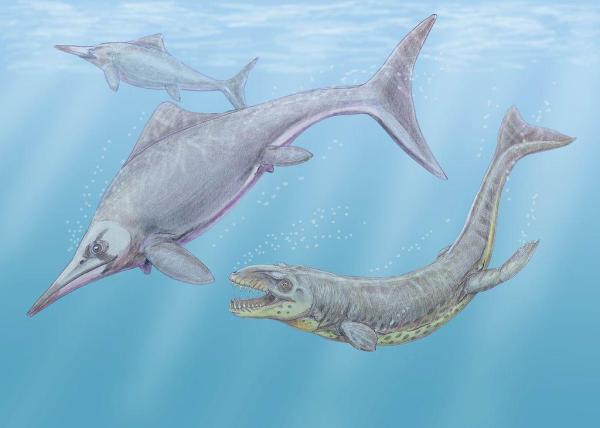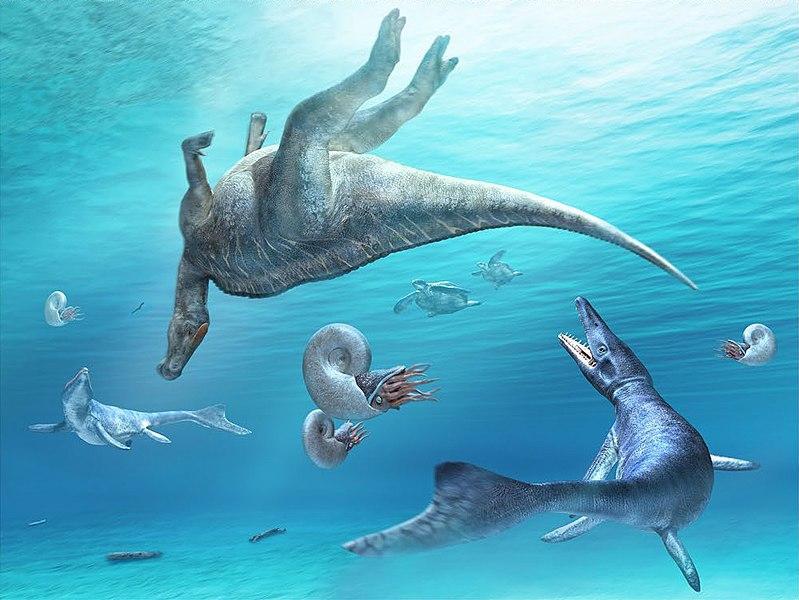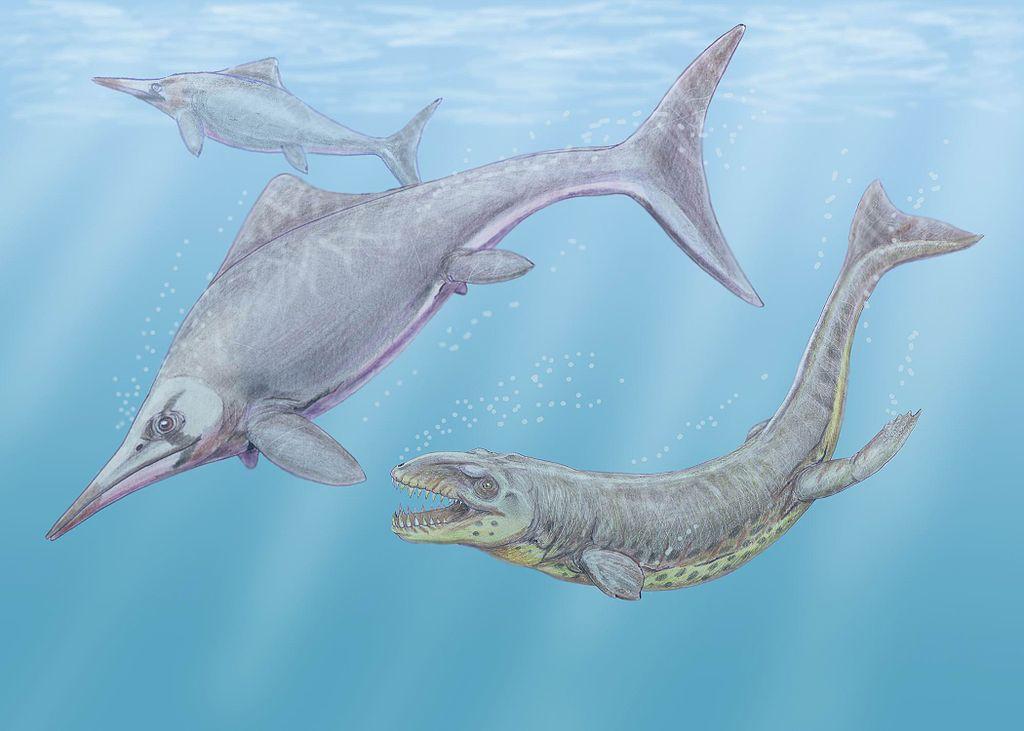Prehistoric Marine Reptiles


Millions of years ago, the oceans teemed with incredible creatures: prehistoric marine reptiles. These weren't actually dinosaurs, but a separate group of reptiles that adapted to life in the water. They ruled the oceans during the Mesozoic Era (252 million to 66 million years ago) and came in a variety of shapes and sizes. These creatures played a crucial role in shaping the oceans and paving the way for the marine animals we see today.
This AnimalWised article dives into the world of prehistoric marine reptiles, exploring their different types and key characteristics.
Are there any marine dinosaurs?
The term "marine dinosaurs" is actually a misconception.
Dinosaurs were a diverse group of land-dwelling reptiles that dominated the Earth for over 160 million years. Their defining features included upright posture, three-toed feet, and a variety of adaptations for bipedalism, herbivory, or predation on land.
While some dinosaurs may have ventured near water or even been good swimmers (like Spinosaurus with its sail and webbed feet), they never truly lived in the ocean.
During the Mesozoic Era, alongside dinosaurs, there were many incredible marine reptiles that dominated the oceans. These creatures, such as plesiosaurs, ichthyosaurs, and mosasaurs, adapted to life in the water and looked superficially similar to dinosaurs in some ways. However, they were not closely related to dinosaurs and belonged to separate evolutionary lineages.
Differences between dinosaurs and prehistoric marine reptiles
While both terms are often associated with the prehistoric era, dinosaurs and marine reptiles represent distinct groups of creatures that ruled their respective domains: land and sea. Here's a breakdown of the key differences:
Habitat
- Dinosaurs: exclusively land-dwelling reptiles. They dominated terrestrial ecosystems for over 160 million years during the Mesozoic Era.
- Marine reptiles: as the name suggests, these creatures thrived in the oceans during the same period. They were not a single group but rather a collection of diverse reptiles that adapted to aquatic life.
Evolutionary lineage
- Dinosaurs: belonged to a specific group of archosaurs, a diverse lineage of reptiles that also included ancestors of crocodiles and birds.
- Marine reptiles: evolved from separate lineages of reptiles entirely. Some, like ichthyosaurs, were more closely related to extinct marine reptiles than to dinosaurs. There are no direct descendents of marine reptiles alive today. These incredible creatures, like plesiosaurs, ichthyosaurs, and mosasaurs, all went extinct during the mass extinction event that occurred at the end of the Cretaceous period, about 66 million years ago.
Adaptations
- Dinosaurs: which developed features for land-based life, exhibited an upright posture with strong legs for walking or running. Additionally, they possessed specialized feet with three or four toes and displayed diverse body sizes and shapes suited for herbivory, predation, or flight (in the case of birds).
- Marine reptiles: evolved a variety of adaptations for swimming and survival in the ocean. These included streamlined bodies for efficient movement in water, paddle-like limbs or fins for propulsion, and tails modified for swimming or diving. Furthermore, in some cases, they developed adaptations for breathing air while remaining mostly submerged, such as nostrils positioned on top of the head.
Want to learn more about fearsome predators? Check out our Top 7 carnivorous dinosaurs.
Origin of marine reptiles
The story of marine reptiles starts over 320 million years ago with terrestrial ancestors venturing into water.
This transition wasn't a single event; different reptile groups adapted to aquatic life at various times.
Prehistoric marine reptiles:
- Ichthyosaurs: these reptiles emerged in the early Triassic period (around 250 million years ago). They transitioned from land dwellers to efficient swimmers with fish-like bodies.
- Plesiosaurs:Plesiosaurs were a diverse group of large marine reptiles that lived during the Mesozoic Era, from the late Triassic to the end of the Cretaceous period.
- Mosasaurs: the late Cretaceous period (100-66 million years ago) saw the rise of Mosasaurs. These formidable predators evolved from land-dwelling or semi-aquatic squamates and dominated the oceans until the Cretaceous extinction event.
Modern marine reptiles:
While true marine reptiles vanished with the dinosaurs, several modern reptiles have adapted to life at sea. Here are some common examples:
- Sea turtles (Superfamily Chelonioidea): emerged as marine creatures in the Cretaceous period, around 110 million years ago.
- Marine iguanas (Amblyrhynchus cristatus): are believed to have appeared relatively recently in evolutionary history, likely within the past few million years.
- Sea Snakes (Subfamily Hydrophiinae): transitioned to a marine lifestyle during the Miocene epoch, specifically from about 23 to 5 million years ago.
- Saltwater Crocodiles (Crocodylus porosus): while adaptable to various water types, trace their origins back to the late Cretaceous period, indicating an adaptation timeline that spans approximately 100 to 66 million years ago.
To survive in the aquatic environment, these reptiles underwent significant anatomical modifications. Their limbs transformed into flippers for efficient swimming, and their body shapes became more streamlined to reduce drag in water. These adaptations showcase convergent evolution, where unrelated groups facing similar selective pressures (moving through water) develop analogous solutions (flippers, streamlined bodies).
Types of prehistoric marine reptiles
Ancient Marine Reptiles, which thrived in the oceans of the Mesozoic Era, represent a fascinating and diverse group of prehistoric animals.
These creatures evolved various adaptations that allowed them to dominate marine ecosystems. Here are the primary types of Ancient Marine Reptiles, categorized by their most recognized families and notable characteristics:
- Ichthyosaurs (Order Ichthyosauria)
- Plesiosaurs (Order Plesiosauria)
- Mosasaurs (Family Mosasauridae)
These ancient marine reptiles thrived in the oceans of the Mesozoic Era (252 million to 66 million years ago). They filled a variety of ecological roles, from near-shore predators to open-ocean hunters. This remarkable diversity in size, body shape, and feeding strategies demonstrates how evolution can lead to a wide range of adaptations in response to changing environments.
Unfortunately, these creatures met their end around 66 million years ago during the mass extinction event that also wiped out the non-avian dinosaurs. This extinction opened the door for the rise of marine mammals and the diversification of modern marine reptiles in later eras.
How did dinosaurs take to the skies? Explore bird evolution in our next article.
Ichthyosaurs (Order Ichthyosauria)
Ichthyosaurs (Order Ichthyosauria) represent a distinct group of marine reptiles, whose physical form closely resembles that of cetaceans and fish. This similarity, however, does not stem from direct relatedness but from evolutionary convergence. A process where unrelated species develop analogous structures due to similar environmental pressures.
Adapted for deep-sea hunting, ichthyosaurs shared ecological niches with modern dolphins, equipped with teeth suited for capturing prey such as squid and fish.
Notable ichthyosaur genera include:
- Cymbospondylus
- Macgowania
- Temnodontosaurus
- Utatsusaurus
- Ophthalmosaurus
- Stenopterygius

Plesiosaurs
Plesiosauria, an order encompassing a wide array of large marine reptiles.
Plesiosaurs thrived from the Late Triassic until the end of the Cretaceous period, approximately 66 million years ago, coexisting with dinosaurs until both groups were extinguished by the mass extinction event at the Cretaceous-Paleogene boundary.
Physically, plesiosaurs were characterized by their unique body plan, which notably included a long neck and a small head, similar in appearance to the mythical Loch Ness Monster, albeit without a shell and having a more elongated body. This group of carnivorous reptiles had a diet that included fish and cephalopods, such as the now-extinct ammonites and belemnites.
Examples of plesiosaurs:
- Plesiosaurus
- Kronosaurus
- Liopleurodon
- Microcleidus
- Elasmosaurus
Discover the incredible diversity of reptiles that dominated both sea and freshwater habitats.

Mosasaurs
Mosasaurs, belonging to the family Mosasauridae, were dominant marine predators during the Cretaceous period. They were not lizards but marine reptiles closely related to snakes and lizards. Ichthyosaurs and plesiosaurs were indeed extinct by the time mosasaurs thrived.
These aquatic reptiles ranged in size from 3 to 18 meters and physically resembled crocodiles. They inhabited warm, shallow seas where they preyed on fish, diving birds, and other marine reptiles. Examples of mosasaurs include:
- Mosasaurus
- Tylosaurus
- Clidastes
- Halisaurus
- Platecarpus
- Tethysaurus
In Jurassic World, the Mosasaurus is depicted, which could potentially be M. hoffmanni, the largest known mosasaur species, reaching up to 18 meters in length.
Discover the diverse world of water insects in our next article.

If you want to read similar articles to Prehistoric Marine Reptiles, we recommend you visit our Facts about the animal kingdom category.
- Jiménez, E. & Civis, J. (2003): Fossil vertebrates in the history of life. Excavation, study and heritage . Univ. Salamanca Editions.
- Brusatte, SL (2012): Dinosaur Paleobiology. Wiley-Blackwell.
- Benton, M.J. (2004): Vertebrate paleontology . Blackwell Publishers.
- Ellis, R (2003): Sea Dragons - Predators of the Prehistoric Oceans . University Press of Kansas
- Williston, SW (1903): North American plesiosaurs. Field Columbian Museum, Geology Series, 73 (2), pp. 1-79.
- Luan, Xianghong et al. (2010): The Mosasaur Tooth Attachment Apparatus as Paradigm for the Evolution of the Gnathostome Periodontium . National Center for Biotechnology Information 11 (3), pp. 247-259.








